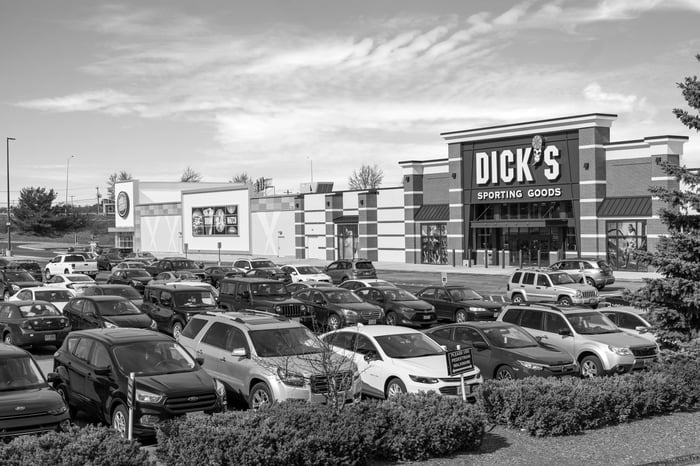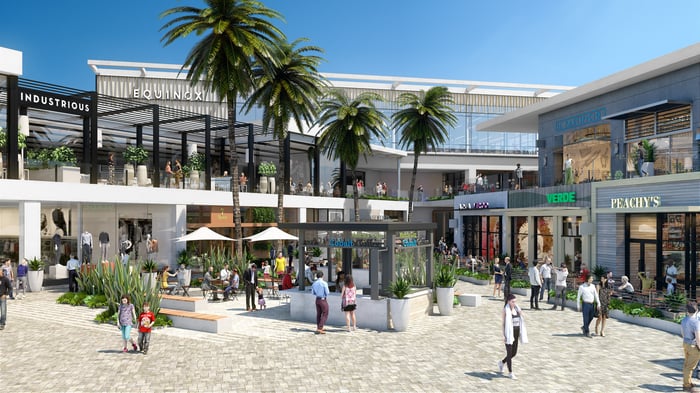Back in 2015, Seritage Growth Properties (SRG -0.99%) was formed to buy a substantial chunk of Sears Holdings' real estate, giving the struggling retail icon a $2.7 billion cash infusion.
At the time of the sale, nearly all of the properties were leased back to Sears and Kmart. However, Seritage aimed to gradually redevelop those properties by splitting up large-format Sears and Kmart stores into smaller spaces that could be rented to higher-paying retail tenants.
Seritage Growth Properties ran into numerous obstacles while trying to execute its redevelopment plan. Now, under new CEO Andrea Olshan, it appears to have abandoned this strategy altogether.
A series of setbacks
While Seritage always planned to reduce its exposure to Sears and Kmart over time, both retailers fell out of favor rapidly over the past five years. The result was that Sears Holdings filed for bankruptcy protection three years ago. The company closed stores at a rapid pace before, during, and after the bankruptcy. At the beginning of 2016, there were more than 1,600 Sears and Kmart stores in the United States. Today, there are just a few dozen -- and none at all in Seritage's portfolio.
The rapid loss of all of its Sears and Kmart stores dealt a huge blow to Seritage Growth Properties' cash flow. The REIT simply couldn't redevelop properties as quickly as its Sears and Kmart stores closed, leaving more than three-quarters of its square footage vacant.

Image source: Seritage Growth Properties.
The COVID-19 pandemic added to Seritage's woes. Entering 2020, it had annual in-place rent of $108 million and leases signed for future occupancy totaling $84 million of annual base rent. However, its tenant roster was heavily tilted toward gyms, restaurants, movie theaters, and family entertainment centers. Many of these companies slowed or canceled expansion plans during the pandemic. Some even went bankrupt.
As a result, by the end of September, in-place rent had fallen to $92 million. Moreover, Seritage now has just $29 million of leases signed for future openings. Making matters worse, competition with other shopping centers has increased, due to the surge in store closures over the past couple of years. That has negatively impacted the leasing environment.
Goodbye, retail?
Seritage Growth Properties is reacting to this unfavorable environment by changing its strategy. In its third-quarter earnings release, it stated, "The last two multi-tenant retail development projects ... are slated for their grand openings in the fourth quarter of 2021 and third quarter of 2022, respectively."
Going forward, Seritage plans to focus on residential development at about three dozen sites, along with seven "premier mixed-use properties" that will include a variety of retail, office, life sciences, and residential uses.
To be clear, Seritage's business plan has always included these types of projects. However, they were previously supposed to be a complement to the REIT's core business of developing and operating retail properties. Now, Seritage appears to be scrapping most of its retail redevelopment pipeline and selling those properties to cover its cash burn and raise money to fund future capital spending.

Image source: Seritage Growth Properties.
New potential and new pitfalls
On one level, Seritage's strategy shift makes sense. The U.S. retail market has been oversaturated for years, whereas there is a severe housing shortage. That has led to a ton of investor demand for residential assets (i.e., high valuations for completed projects).
Yet Seritage will face new challenges with its new strategy. First, it will need to get entitlements to build residential buildings on its commercial properties. This tends to be a lengthy process, and sometimes local officials won't approve entitlements due to concerns about traffic, school overcrowding, or erosion of the commercial tax base (to give a few examples).
Second, returns for residential development tend to be much lower than for retail development. In early 2020, Seritage estimated that its initial batch of mixed-use and multifamily projects would generate a yield on cost of less than 7%, compared to double-digit average returns for its retail projects.
The higher valuations of completed residential projects (compared to most retail properties) can compensate for those low yields on investment. However, Seritage would have to invest a huge amount of money to get a meaningful cash flow boost from residential development. That's a problem because the REIT is currently burning over $100 million a year excluding redevelopment spending.
Seritage ended Q3 with over $160 million of cash and $224 million of asset sales under contract, so it has plenty of cash for now. But because it will take so long to generate a meaningful income stream from residential and mixed-use properties, interest costs and operating expenses (rather than productive redevelopment spending) will soak up much of Seritage's cash and future asset sale proceeds. Unless management can solve this conundrum, Seritage's strategy shift won't lead to big gains for shareholders.





